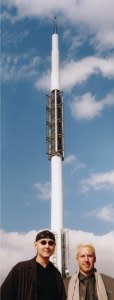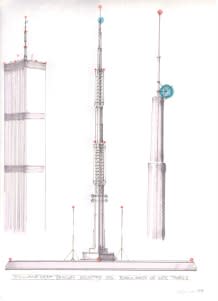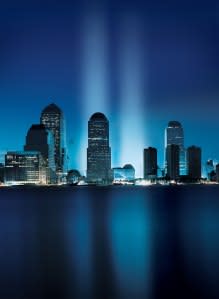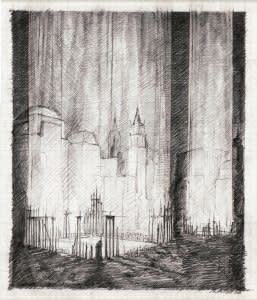Artists Behind 'Tribute in Light' 9/11 Memorial Continue to Inspire: 'People Could Start Looking Up Again'
The installation’s collection of 88 beams will illuminate the night sky above Lower Manhattan on Monday night, creating two pillars of light that will stretch four-miles-high. The display has become one of the most recognized and unique public art installations in the world since its unveiling on March 11, 2002.
For the 16th anniversary of September 11, Myoda and LaVerdiere spoke with PEOPLE about the journey of turning the idea into reality, and their hopes that it remains a symbol of healing and peace—for all people—into the future.

“I was in disbelief, I was immediately thinking about the people I knew in there,” Myoda, 50, tells PEOPLE of witnessing the World Trade Center burn on September 11, 2001. “There was panic throughout the day.”
In the months leading up to the attacks, Myoda and LaVerdiere had taken up residence on the 91st floor of Tower 1 of the World Trade Center. They were designing an art installation that would be placed atop of the tower—a bioluminescent beacon to commemorate the mapping of the human genome. While designing the display, the two frequently took trips to the top of the tower with engineers and studied the angles of the buildings from different areas around NYC.
Becoming so intimately acquainted with the towers while designing the beacon changed how they initially felt about them—while they thought the towers were “alienating” from the outside, Myoda and LaVerdiere soon appreciated the complex world that thrived within them.
“I started thinking of the towers as a living body, because there are so many people in them, the buildings were like a coral,” LaVerdiere says. “They were as much flesh and soul as they were concrete.”
Then, on a September morning, nearly 3,000 people lost their lives when the buildings came crashing down.

“The towers had always been this marker, a sort of nautical point you could use in the city to help you find your way around,” LaVerdiere continues. “That marker was replaced by the plume of apocalyptic smoke and light that was disorienting and created a phantom limb sensation. It felt like the buildings were still there, hidden behind the smoke.”
On September 12, the morning after Myoda and LaVerdiere studied the cloud looming over Ground Zero, they were contacted by editors from The New York Times Magazine who had previously covered the production of their bioluminescent beacon. The magazine was seeking artists to create visual responses to the attacks in their upcoming issue. Myoda and LaVerdiere instinctively knew they would use the image they imagined the night before.
“We were grateful to be asked to do something, everyone was trying to figure out what they could do—give blood, donate, something—and we basically sat down the next day and made the image,” Myoda says.

The men sat in front of a computer and Photoshopped beams of light into a photograph of the NYC skyline after the attacks, taken by Times photographer Fred Conrad. The Times liked their submission so much that they placed it on the cover of the September 23 issue, and the reaction ignited a movement to bring it to fruition.
“There was such an overwhelmingly positive response for the light beacons because it was the first thing that hit the news cycle that was positive, in contrast to pictures of the blasts and explosions,” LaVerdiere explains.
When the magazine was released, the cover looked so real that people asked if Myoda and LaVerdiere actually set up lights in the city for the photograph.
“I had to tell them that it was just an image,” Myoda says. “But while we were designing it, we did think to ourselves that once things settle down, there’s a possibility we can make this virtual image into an actual installation.”

With growing support for their idea after the release of the issue, Myoda and LaVerdiere teamed up with architects to design a way to bring the lights to life.
The team began meeting with families of 9/11 victims to discuss the plan. It was in one of the town halls that a woman remarked that the original name of the project, “Towers of Light,” placed too much emphasis on the buildings, and not enough on the people. The artists agreed, and “Tribute in Light” soon became its new name.
While the meetings were productive, they faced roadblocks in other areas. At one point in the process, the artists say Mayor Rudolph Guiliani requested them to change the lights from white, to red, white and blue. “We told him there was no way we were going to do that,” Myoda says. “There were more than 90 countries who lost citizens in the towers.”
Because of this, the installation was delayed until the inauguration of Mayor Michael Bloomberg, who had a better understanding of their vision and gave them the green-light right away, they say. On March 11, 2002, on the six-month-anniversary of the attacks, 88 spotlights were placed in two 48-foot squares, ready to illuminate the Manhattan sky.
“We wondered if it would work, not physically, but, what if it made the public angry or unsettled people? What if it’s garish or tasteless?” LaVerdiere says. “There was worry about how it was going to be received. We were worried it was going to open wounds rather than heal them.”

Both men were taken aback when the lights came on.
“When the lights appeared for the first time, it was one of the most peaceful and silent events I had ever witnessed,” Myoda says. “Until that night, I don’t recall ever being in New York and hearing so little. When the lights were on, everything seemed to stop. It was incredibly quiet.”
As one construction worker told the artists, after six months of looking into a pit, “people could start looking up again. ”
“That night was the first time that it seemed like everybody could gaze into the infinite, and not into an abyss,” LaVerdiere says.
Since then, the installation has been put into operation every evening of September 11, and turned off just before dawn the following morning.

In the years after the attacks and after completion of the memorial, both Myoda and LaVerdiere experienced a change in perspective. For Myoda, after ceasing to make art for a few years, he became interested in conceptual architecture and experimental pieces on a small scale. LaVerdiere’s work became political, and he sought out pieces that focused on collaboration, rather than an individual person or voice. After the emotionally taxing experience of creating the 9/11 installation, both say they have no interest in creating another public memorial again.
But Myoda says he remains heartened by the public’s appreciation of the installation after all these years.
“Being an abstract artist, and to see people understand what the tribute is—even though it’s so abstract—made me very happy,” he says. “People realized that art has a potential healing power.”
It is partly because of this power that the artists don’t want “Tribute in Light” to morph into an image nationalism, as Guiliani wanted to do back in the project’s infancy. During this politically turbulent time, Myoda and LaVerdiere want everyone who views the memorial tonight to remember what it was meant to signify.
“There was so much hatred and anger back then, and for us, this gesture was meant to be a symbol of remembrance and peace,” LaVerdiere says. “The lives that were lost in the city that day involved a huge cross-section of culture and demographics. This tribute was never meant to only symbolize America, it was meant to symbolize the loss of life, period. All of them. There are no borders on life.”

